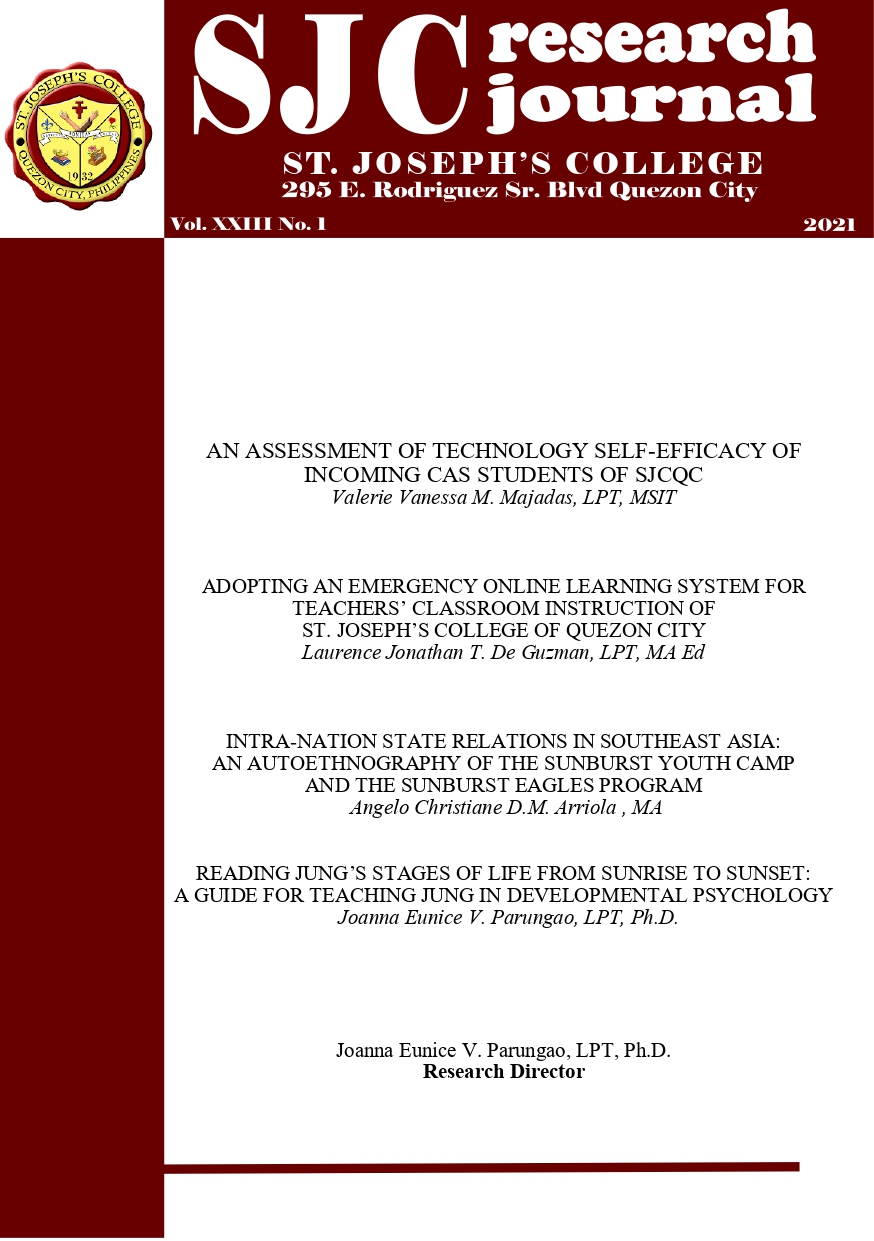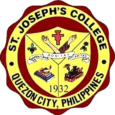Online Registration
Facilities
Research Journal

ADOPTING AN EMERGENCY ONLINE LEARNING SYSTEM FOR
TEACHERS’ CLASSROOM INSTRUCTION OF
ST. JOSEPH’S COLLEGE OF QUEZON CITY
Laurence Jonathan T. De Guzman, LPT, MA. Ed
Abstract
The adoption of an emergency online learning system in the Philippines has prompted St. Joseph’s College of Quezon City (SJCQC) to adopt a new instructional mode which utilizes the use of online learning management systems. Pursuant to this mandate by the government, SJCQC has equipped its teachers with the necessary tools to guide them in their adoption of a new mode of instruction through in-house seminars and workshops. In this study, the researcher sought to determine the effects of this paradigmatic shift in classroom instruction by interviewing 13 subjects from SJCQC Senior High School/College Department, Special Education Department, and
Basic Education Department against the backdrop of Picciano’s multimodal analysis model of blended pedagogical purposes. The study found that, while the subjects use several of Picciano’s models, reflection and social/emotional aspects are lacking. However, it appears that the social and emotional aspects are complied with when viewed from the perspective of modern research of Miran-Lopez (2019). Nonetheless, the act of reflection through journaling/blogging is proposed, to help integrate a practice that amounts to self-reflexivity. A revision of Picciano’s model is also proposed, subject to further research.
Keywords: Online Learning, Online Classroom Instruction, Classroom Techniques, Classroom Engagement, Blended with Purpose
An Assessment of Technology Self-Efficacy of Incoming CAS Students of SJCQC
Valerie Vanessa M. Majadas, LPT, MSIT
Abstract
This study aimed to assess the technological literacy of the incoming students in the College of Arts and Science of St. Joseph’s College of QC using the International Society for Technology in Education (ISTE) National Educational Technology Standards for Students (NETS-S) standard. The study’s respondents are 44 new students of the College of Arts and Sciences during the first semester of the school year 2021-2022. Results showed that Computational Thinker garnered the lowest mean score of 2.79, indicating medium level self-efficacy. This means that students are not always comfortable using technology to collect, evaluate, and present data for problem-solving
and decision-making. Based on the students’ weaknesses in each ISTE standard, 26 will undergo remediation and each student may need to remediate multiple standards. Computational Thinker has the most students (20), followed by Technical Proficiency (10), Creative Communicator (9), Global Collaborator (5), Knowledge Constructor (3), and Digital Citizen (1 student). The action plan was based on the assessment result which was used to generate computer-training outcomes with verifiable indicators on how to bridge the skills students lack to perform better as they enter the college level.
Keywords: Action Research, Technological Literacy, Self-Efficacy
READING JUNG’S STAGES OF LIFE FROM SUNRISE TO SUNSET:
A GUIDE FOR TEACHING JUNG IN DEVELOPMENTAL PSYCHOLOGY
By Joanna Eunice V. Parungao, LPT, Ph.D.
Abstract
Most theories on human development are based on age, biological constructs, crises, and abilities. Carl Gustave Jung can be considered a divergent psychologist since he did not confine himself with empirical data. Much of his works show his interest in the spiritual path. It does sound ironic when the topic is psychology, when psyche by definition, means spirit and yet little is discussed about the spirit in psychological theories. This article was embarked to help illustrate and digest the details of Jung’s Stages of Life. It is also the aim of this paper to summarize and interpret pragmatically the mystic qualities of Jung’s concepts by providing current relatable issues to encourage readers, teachers, and students to investigate further and experience the contributions of Jung to the study of the unconscious.
Keywords: Carl Jung, Stages of Life
Intra-Nation State Relations in Southeast Asia:
An Autoethnography of the Sunburst Youth Camp
and the Sunburst Eagles Program
by Angelo Christiane D.M. Arriola
Abstract:
Official ASEAN documents show that the objectives of the Singapore Technologies Endowment Programme (STEP)’s Sunburst Youth Camp and the Sunburst Eagles Program hew closely to the objectives of the ASEAN. Using autoethnography as a research method and Meta Nation State Relations as a framework, the author as a participant examines the two programs as vehicles of Intra-State Nation relations in Asia. The author, as a student at St. Joseph’s College, represented the Philippines in the Sunburst Youth Camp in 2001. Each ASEAN member state mounted its country exhibit. The exhibits were part of the “Knowing ASEAN” seminar, which aimed to present each country “in all its socioeconomic and cultural aspects.” The highlight of the entire Sunburst Youth Camp was the Cultural Nite, when each country would present “traditional” dances. In 2011, the author returned to Singapore as one of the 28 Sunburst Youth Camp alumni chosen to participate in the first-ever Sunburst Eagles Program. Sunburst Eagles is also an example
of Intra-Nation State relations but for professionals. These two programs, as well as other STEP programs, can serve as models to state actors in Asia and beyond. These state actors can use STEP programs to foster better relations with other nations.
Keywords: Autoethnography, Intra-Nation State Relations in Southeast Asia, ASEAN
SOLAR VAULT: Solar Heat Storage and
Electric Conversion Device
Valerie Vanessa M. Majadas 1
, Sixto Marvin R. Torres 2
, Jose Maria M. San Juan 3
,Harold Jacob C. Villanueva 4
, Emilio C. Castillo 5
Abstract
This study aims to develop Solar Vault, a three-part hybrid system designed for solar heat collection, storage, and electrical conversion in off-grid coastal communities. Inspired by the EuroDish CSP system, Solar Vault uses a parabolic dish mirror to focus sunlight onto a sand battery, which stores heat for conversion into electricity via SP1848-27145 SA thermoelectric generators. Designed for accessibility, it is a fully manual, DIY system built from readily available materials.
This study utilizes an applied research design, including a developmental research design and a descriptive quantitative research design. The developmental research design enables researchers to design, develop, test, and refine Solar Vault to assess its full capabilities and limitations. The descriptive research design allows the researchers to analyze the results of the data by calculating using the formulas and then presenting them in graphical form to determine the characteristics of the relationship between the variables. Results show that the system maintained a cold-side temperature of 21°C, while the hot side exceeded 100°C, creating an 80°C temperature difference, which is a notable improvement in thermal efficiency over prior studies.
Electrical performance testing revealed a peak power output of 1.86W (6.40V, 0.29A) and an average of 1.07W (3.91V, 0.23A) over 30 minutes, outperforming previous research. Efficiency analysis showed a maximum of 6.41% at 1.52W, surpassing prior systems’ 4.80% peak efficiency at 0.09W. However, the sand battery exhibited poor heat retention, stabilizing at 30°C after 300 minutes, significantly underperforming compared to existing thermal storage methods. Load testing demonstrated that Solar Vault could power small devices, such as a 3V LED, DC electric motor, and 12V ducted fan, though it suffered from voltage drops averaging 43.09%, indicating inefficiencies in voltage regulation. While the device was unable to achieve its target output of 12V, 1A, it successfully generated usable power. The study concludes that Solar Vault is a viable thermoelectric generator for off-grid use but requires improvements in heat storage and electrical efficiency. Recommendations include exploring alternative thermal storage designs, optimizing voltage regulation, improving parabolic mirror design, and conducting further tests in optimal weather conditions
Keywords— Hybrid System, Intermittency, Mechanical complexity, Seebeck Effect, Thermoelectric Generators (TEGs).
C.O.C.O.S.: Coconut Husk Optimization
for Clean-up of Oil Spill
Valerie Vanessa M. Majadas 1
, Carl Albert L. Durian 2
, Jamealla Shannen C. Almazan 3
,Divina Joy S. Mendoza 4
, Clarisse Anne D. Montes 5
, Hugh-one Mhyckiel M. Bautista 6
Abstract
This study aims to develop a product for oil spill clean-up with the use of coconut husk as a natural
adsorbent. Coconut husks are frequently discarded as waste. This contributes to environmental pollution. To help reduce waste in the environment, re-purposing it as an adsorbent for oil spill clean-up helps make it a beneficial solution to society. Coconut husk is easier to find and widely available compared to other adsorbents like hair. Additionally, due to its natural lignin and cellulose content, its water-resistant nature makes it more effective in separating oil from water. This provides an eco-friendly and practical alternative. Every day, hundreds to thousands of spills occur globally, including in marine environments. Oil spills result in major economic damage and long-term harm, which gives a significant problem to ocean ecosystems. This study utilizes a development research design, which focuses on designing, testing, and evaluating a device that enhances oil spills clean-up.
The device was developed to maximize the oil adsorption properties of coconut husk and evaluate its effectiveness under controlled conditions. Tests conducted proved the C.O.C.O.S device to be an eco – friendly solution for oil spills. Using heated coconut husk as the main adsorbent recorded an oil adsorption capacity of 34.62% within 30 minutes, it adsorbed 64.29% of oil much faster than 44.33% adsorption over 60 minutes as reported by Anawa and Ewemoje (2021) and retained 93.33% of the adsorbed oil after just 5 minutes. The results show that the coconut husk is effective in adsorbing oil, supporting the findings of Kelle and Eboatu (2018), who emphasized its high oil adsorption and retention properties. The formula of Xiang (2011) was used to measure adsorption as well. Based on the results, the researchers recommend additional analysis regarding the efficacy of coconut husk
adsorption in actual water bodies, testing its effectiveness on various oils, and adapting different processing techniques such as carbonization or powdering to increase its adsorption and structural durability. Design and testing refinements will confirm in the future C.O.C.O.S. as an effective, economically friendly, and green method for oil spill remediation.
Keywords— Oil Adsorption, Bioremediation, Coconut Husk Optimization, Oil spill Remediation






